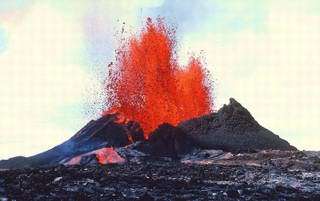Study Reconciles Long-Standing Contradiction of Deep-Earth Dynamics

Scientists at Columbia University's Lamont-Doherty Earth Observatory (LDEO) have solved a long-standing contradiction about the workings of the deep Earth.
Image: The chemical composition of ocean-island lavas support the idea that the Earth's deep mantle has been continually moving and mixing. Credit: LDEO
While some geochemists have argued that parts of the deep mantle have remained unchanged since the formation of the Earth, some geophysicists and others have believed that the entire mantle has been moving throughout geologic time. The question of whether the deep-Earth changes is central to scientists' understanding of the process of heat loss from deep beneath the surface.
LDEO earth scientists Cornelia Class and Steven Goldstein now show that the evidence favors a moving mantle, with the deepest parts of the Earth affected by the same tectonic processes that occur at the surface. The study appears in the Aug. 25 issue of the journal Nature.
"For 30 years scientists have debated whether there is a layer of the mantle that has remained unchanged since the formation of the Earth," said Class. "We found the strongest evidence yet that indicates the opposite is true."
Class and Goldstein's re-evaluation of this concept of the inner Earth is based on their work with two new databases: the Petrological Database of Ocean Floor Basalts (PetDB) and Geochemistry of Rocks from the Oceans and Continents (GEOROC).
Scientists have known that upper mantle basalt found at mid-ocean ridges, formed by sea-floor spreading, comes from previously formed oceanic and continental crust. The new global data synthesis demonstrates that ocean island lavas, chemically most like mid-ocean ridge basalt, were previously processed by plate tectonics, say Class and Goldstein, indicating that the deep mantle has been continually moving and mixing.
This result adds to growing evidence "that most of Earth's mantle has been subject to the same forces that drive the movements of Earth's crust," said Sonia Esperanca, a program director in the National Science Foundation (NSF)'s Division of Earth Sciences, which funded the research.
Source: NSF















